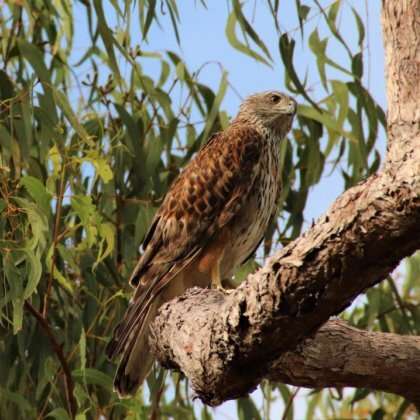This article has been reviewed according to Science X's editorial process and policies. Editors have highlighted the following attributes while ensuring the content's credibility:
fact-checked
trusted source
proofread
Australia's rarest bird of prey disappearing at alarming rate

Australia's rarest bird of prey—the red goshawk—is facing extinction, with Cape York Peninsula now the only place in Queensland known to support breeding populations.
Ph.D. candidate Chris MacColl from The University of Queensland's School of Earth and Environmental Sciences led the research project that made the discovery and was shocked by the hawk's dwindling numbers. The research is published in Emu—Austral Ornithology.
"Over four decades the red goshawk has lost a third of its historical range, which is the area that's it's previously been known to occupy," Mr. MacColl said. "It's barely hanging on in another 30% of regions it has previously been known to inhabit."
Mr. MacColl said the species is now considered extinct in New South Wales and the southern half of Queensland.
"There has been a noticeable decline in North Queensland too, leaving Cape York Peninsula as the last place in the state still known to support breeding populations," Mr. MacColl said.
"The Top End, Tiwi Islands and Kimberley are the red goshawk's last remaining stronghold, making northern Australia critical to its ongoing survival."
The unique bird of prey has long captivated bird watchers, with its striking reddish-brown plumage, deeply fingered wing tips, heavy yellow legs and over-sized talons.
The research team analyzed four decades of sightings by citizen scientists to uncover the concerning population trends.
"The threats driving the red goshawk's decline require further investigation, but we believe habitat loss and degradation have played a key role," Mr. MacColl said.
Study co-author Professor James Watson said the dramatic loss of the species means governments and communities need to be proactive in conserving remaining habitats.
"An increase in agricultural, mining and gas projects across northern Australia pose a real risk to a species like this, given what we've observed throughout its eastern range," Professor Watson said.
"Northern Australia supports the largest intact tropical savanna ecosystem in the world and hosts an abundance of biodiversity.
"Conservation efforts aimed at securing an emblematic species like the red goshawk in these areas will benefit many other species given the species is a top-predator."
The study authors back calls for the Commonwealth Government to amend the red goshawk's national conservation status from Vulnerable to Endangered, so the bird can be afforded greater conservation priority.
More information: Christopher MacColl et al, Rapid and recent range collapse of Australia's Red Goshawk Erythrotriorchis radiatus, Emu—Austral Ornithology (2023). DOI: 10.1080/01584197.2023.2172735
Provided by University of Queensland




















